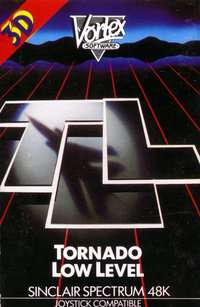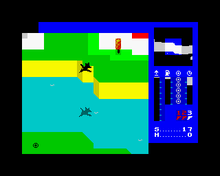Tornado Low Level
Tornado Low Level (also known as T.L.L.) is a multidirectional shooter developed by Costa Panayi and published in 1984 by the company he co-founded, Vortex Software. The game was released for the ZX Spectrum in 1984, with ports for the Amstrad CPC and Commodore 64 in 1985.
| Tornado Low Level | |
|---|---|
 ZX Spectrum cover | |
| Developer(s) | Costa Panayi |
| Publisher(s) | Vortex Software |
| Designer(s) | Costa Panayi |
| Programmer(s) | ZX Spectrum Costa Panayi Amstrad CPC David Aubrey-Jones Commodore 64 Simon Nicol |
| Platform(s) | |
| Release | 1984: Spectrum 1985: Amstrad, C64 |
| Genre(s) | Multidirectional shooter |
| Mode(s) | Single-player |
The game has the player control a Panavia Tornado fighter jet, tasked to destroy targets throughout the map. Tornado Low Level received positive reviews for the ZX Spectrum and Amstrad CPC versions by video game critics, both on release and in retrospective reviews. The game was also a commercial success, with the Spectrum version debuting at number three on Personal Computer Games' top fifty charts. The success of the game led to a sequel titled Cyclone, which featured a similar graphical style and similar play.
Gameplay

The player controls a Panavia Tornado fighter jet and must manoeuvre the plane at low altitude in order to destroy targets on the landscape by flying very low over them at high speed, while avoiding pylons, bridges, and other structures. Each target is represented as a small circle.[1] After five targets are destroyed, new targets are placed in more difficult positions, like in the water.[2]
Before a level begins, the map of the area is shown, with the five targets being highlighted.[3] Each level has a time limit, while the Tornado has a limited fuel supply and can only carry ten bombs. Running low on fuel and time causes a warning sound to be triggered. Landing on the airfield refuels the aircraft.[1] The Tornado has two speeds. At high speed, it can travel to targets faster. However, it uses fuel at a much greater rate. This is depicted graphically by the plane's wings being swept back. The screen displays a fuel gauge, altimeter, a map of the game, and the time the player has left.[4]
The 3D aspect of the game allows the Tornado to not only move on the x-axis (left/right on screen) and the y-axis (up/down on screen), but also on the z-axis, representing the height of the plane in the sky. This movement is supported graphically by allowing the Tornado to fly underneath bridges, with the plane temporarily disappearing from view as it does so. Telephone lines can also be flown under in the same way. Additionally, when the Tornado flies over a building, its shadow "climbs" up the wall, again giving the illusion of a 3rd dimension.[5]
Development
Tornado Low Level was developed by Costa Panayi and published by the United Kingdom-based company Vortex Software, co-founded by Panayi. Before getting into game development, he was a design engineer for British Aerospace. The idea for the game originated from the popularity of Psion's flight simulator program Flight Simulation. Panayi considered the game to be a "progression of the ideas" he had in his previous title Android Two.[5] It was originally released for the ZX Spectrum in 1984.[6] Publisher Ocean Software later acquired the rights to the game to release it for the Commodore 64.[7] An Amstrad CPC version was also released, rewritten to use the full capabilities of the computer. The CPC version was programmed by David Aubrey-Jones.[8]
Reception and legacy
| Reception | ||||||||||||||||
|---|---|---|---|---|---|---|---|---|---|---|---|---|---|---|---|---|
| ||||||||||||||||
Upon release, Tornado Low Level was a commercial success, with the ZX Spectrum version debuting at number three on Personal Computer Games' top fifty charts.[11] Both the ZX Spectrum and Amstrad CPC versions of the game received positive reviews from video game critics. Computer & Video Games called it the best flight game on the Spectrum.[9] Bob Wade, writing for Amstrad Action, praised the game for its graphics and for having the fastest and smoothest scrolling on the Amstrad computer.[1] A reviewer for Amtix also praised the scrolling, but criticized the graphics for looking "blocky".[8] Crash noted a lack of instructions and indications of how to complete the game's objectives.[2] Retrospective reviews were also positive. Peter Parrish, writing for Eurogamer, called it "Gorgeous, absorbing and, despite the subject matter, surprisingly non-violent".[12] Nick Thrope, writing in Retro Gamer, gave it praise for its entertainment value.[13]
Jim Watson of ZX Computing listed it as one of the best games for the ZX Spectrum in 1984.[14] The game was voted number ten in Your Sinclair's "Official Top 100 Games of All Time".[15] Retro Gamer, meanwhile, ranked it as the eleventh best game for the Spectrum.[16] In 1987, Wade listed it as one of the best games for the then two-year old Amstrad CPC.[17]
With the success of Tornado Low Level, Vortex Software released Cyclone in 1985. A sequel to T.L.L., Cyclone has the player fly a helicopter to collect medical supplies in the middle of a cyclone phenomenon.[18]
References
- Wade, Bob (February 1986). "Action Test". Amstrad Action. No. 5. pp. 48–49.
- "Reviews". Crash. No. 7. August 1984. pp. 14–15.
- Holman, Ross; Nicholls, Dave (October 1984). "TLL Tornado Low Level". Your Spectrum. No. 8. pp. 43–47.
- Bourne, Chris (September 1984). "Low Level High-Flyer". Sinclair User. No. 30. p. 37.
- Bourne, Chris (November 1984). "Flying Low". Sinclair User. No. 32. pp. 138–139.
- Stone, Tim (22 February 2019). "The Flare Path: A Tornado Miscellany". Rock, Paper, Shotgun. Retrieved 27 March 2019.
- "Designer of the Month". Computer and Video Games. No. 36. October 1984. p. 24.
- "Reviews". Amtix. No. 4. February 1986. p. 20.
- "Reviews". Computer and Video Games. No. 34. August 1984. pp. 36, 38.
- Roberts, Mike (February 1986). "Reviews". Computer Gamer. No. 11. p. 70.
- "PCG Top 50". Personal Computer Games. No. 10. September 1984. p. 19.
- Parrish, Peter (24 October 2007). "Tornado: Low Level". Eurogamer. Retrieved 19 March 2019.
- Thrope, Nick (27 April 2016). "Tornado Low Level". Retro Gamer. Retrieved 19 March 2019.
- Watson, Jim (December 1984). "Great Games of '84'". ZX Computing. pp. 153–154.CS1 maint: ref=harv (link)
- "Let the People Decide! The Results!". Your Sinclair. No. 93. Dennis Publishing. September 1993. p. 11.
- "Top 25 Best Spectrum Games Of All Time". Retro Gamer. No. 48. pp. 82–91.
- Wade, Bob (January 1987). "The All-Time Amstrad Top 20". Amstrad Action. No. 16. pp. 60–61.
- Bourne, Chris (January 1985). "Here comes the chopper!". Sinclair User. No. 34. p. 37.
External links
- Tornado Low Level can be played for free in the browser at the Internet Archive
- Tornado Low Level at SpectrumComputing.co.uk
- Tornado Low Level at Lemon 64